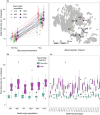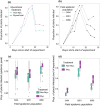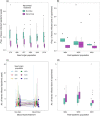Arbuscular mycorrhizal fungi influence host infection during epidemics in a wild plant pathosystem
- PMID: 36093733
- PMCID: PMC9827988
- DOI: 10.1111/nph.18481
Arbuscular mycorrhizal fungi influence host infection during epidemics in a wild plant pathosystem
Abstract
While pathogenic and mutualistic microbes are ubiquitous across ecosystems and often co-occur within hosts, how they interact to determine patterns of disease in genetically diverse wild populations is unknown. To test whether microbial mutualists provide protection against pathogens, and whether this varies among host genotypes, we conducted a field experiment in three naturally occurring epidemics of a fungal pathogen, Podosphaera plantaginis, infecting a host plant, Plantago lanceolata, in the Åland Islands, Finland. In each population, we collected epidemiological data on experimental plants from six allopatric populations that had been inoculated with a mixture of mutualistic arbuscular mycorrhizal fungi or a nonmycorrhizal control. Inoculation with arbuscular mycorrhizal fungi increased growth in plants from every population, but also increased host infection rate. Mycorrhizal effects on disease severity varied among host genotypes and strengthened over time during the epidemic. Host genotypes that were more susceptible to the pathogen received stronger protective effects from inoculation. Our results show that arbuscular mycorrhizal fungi introduce both benefits and risks to host plants, and shift patterns of infection in host populations under pathogen attack. Understanding how mutualists alter host susceptibility to disease will be important for predicting infection outcomes in ecological communities and in agriculture.
Keywords: Plantago lanceolata; Podosphaera plantaginis; mutualism; mycorrhizal fungi; plant disease; plant pathogen; powdery mildew; protective symbiont.
© 2022 The Authors. New Phytologist © 2022 New Phytologist Foundation.
Figures




Similar articles
-
Chemical defense, mycorrhizal colonization and growth responses in Plantago lanceolata L.Oecologia. 2009 Jun;160(3):433-42. doi: 10.1007/s00442-009-1312-2. Epub 2009 Mar 7. Oecologia. 2009. PMID: 19271240
-
Trade-offs between arbuscular mycorrhizal fungal competitive ability and host growth promotion in Plantago lanceolata.Oecologia. 2009 Jul;160(4):807-16. doi: 10.1007/s00442-009-1345-6. Epub 2009 Apr 18. Oecologia. 2009. PMID: 19377897
-
Do fungivores trigger the transfer of protective metabolites from host plants to arbuscular mycorrhizal hyphae?Ecology. 2013 Sep;94(9):2019-29. doi: 10.1890/12-1943.1. Ecology. 2013. PMID: 24279273
-
A meta-analysis of context-dependency in plant response to inoculation with mycorrhizal fungi.Ecol Lett. 2010 Mar;13(3):394-407. doi: 10.1111/j.1461-0248.2009.01430.x. Epub 2010 Jan 19. Ecol Lett. 2010. PMID: 20100237 Review.
-
Preference, specificity and cheating in the arbuscular mycorrhizal symbiosis.Trends Plant Sci. 2003 Apr;8(4):143-5. doi: 10.1016/S1360-1385(03)00012-8. Trends Plant Sci. 2003. PMID: 12711222 Review.
Cited by
-
Involvement of endogenous IAA and ABA in the regulation of arbuscular mycorrhizal fungus on rooting of tea plant (Camellia sinensis L.) cuttings.BMC Plant Biol. 2024 Dec 27;24(1):1266. doi: 10.1186/s12870-024-05955-z. BMC Plant Biol. 2024. PMID: 39731000 Free PMC article.
-
Insight into regulation of adventitious root formation by arbuscular mycorrhizal fungus and exogenous auxin in tea plant (Camellia sinensis L.) cuttings.Front Plant Sci. 2023 Sep 18;14:1258410. doi: 10.3389/fpls.2023.1258410. eCollection 2023. Front Plant Sci. 2023. PMID: 37790788 Free PMC article.
-
Comparative Analysis of Rhizosphere and Endophytic Microbial Communities Between Root Rot and Healthy Root of Psammosilene tunicoides.Curr Microbiol. 2023 May 18;80(7):215. doi: 10.1007/s00284-023-03290-4. Curr Microbiol. 2023. PMID: 37198328 Free PMC article.
-
Colonization by orchid mycorrhizal fungi primes induced systemic resistance against necrotrophic pathogen.Front Plant Sci. 2024 Jul 31;15:1447050. doi: 10.3389/fpls.2024.1447050. eCollection 2024. Front Plant Sci. 2024. PMID: 39145195 Free PMC article.
-
Evolution of sympatric host-specialized lineages of the fungal plant pathogen Zymoseptoria passerinii in natural ecosystems.New Phytol. 2025 Feb;245(4):1673-1687. doi: 10.1111/nph.20340. Epub 2024 Dec 16. New Phytol. 2025. PMID: 39686531 Free PMC article.
References
-
- Azcón‐Aguilar C, Barea JM. 1996. Arbuscular mycorrhizas and biological control of soil‐borne plant pathogens – an overview of the mechanisms involved. Mycorrhiza 6: 457–464.
-
- Bachelot B, Uriarte M, McGuire K. 2015. Interactions among mutualism, competition, and predation foster species coexistence in diverse communities. Theoretical Ecology 8: 297–312.
-
- Barea JM, Azcón R, Azcón‐Aguilar C. 2002. Mycorrhizosphere interactions to improve plant fitness and soil quality. Antonie Van Leeuwenhoek 81: 343–351. - PubMed
-
- Bever JD, Mangan SA, Alexander HM. 2015. Maintenance of plant species diversity by pathogens. Annual Review of Ecology, Evolution, and Systematics 46: 305–325.
Publication types
MeSH terms
LinkOut - more resources
Full Text Sources

